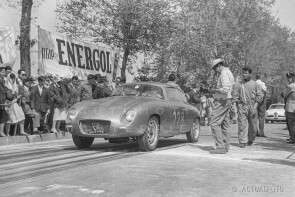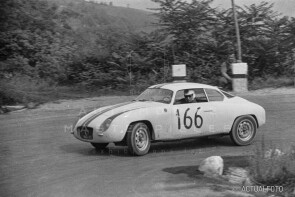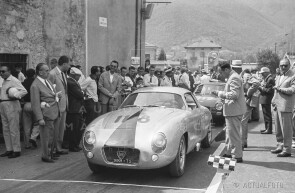
1958 Lancia Appia GTZ
ON/OFF
Why am I an Automotive Masterpiece?
When the Appia left the scene, Ferruccio Bernabò, a well-known journalist and ardent Lancia-lover, wrote: "... you had the look of a young aristocrat, as elegant as sober ... in mechanics, as well as in the line, you had dared to go against the flow - like so many Lancias that preceded you - and for this it was a little difficult for you to impose yourself immediately.” The Appia is a car produced by Lancia from 1953 to 1963; model meant to replace the Ardea. The new car has a very similar line to that of its bigger sister Aurelia.
Zagato's interpretation on the fabulous Lancia Appia, a mid-level 1100cc saloon, came in 1956 with the introduction of the first "prototype", the Appia GTZ, nicknamed "Cammello" for its distinctive double bubble roof design. A remarkable example of minimalist sportiness, it was shown as a one off at the 38th Salone internazionale dell’Auto di Torino where it conquered the public with its unique lines. It was the first effort by Zagato to produce a sporty coupé based on the Appia chassis. Since Lancia was determined to take advantage of the ability of the coachbuilders to produce more variations on the Appia Saloon, introduced in 1955, a special lowered chassis (code 812.01), equipped with a more powerful version of the 1100 cc narrow-V 4 cylinder, was made specifically to be sent to the several ateliers, so popular in those days. Pinin Farina, Vignale and Alemanno went all to produce their variations of the Appia, but it was Zagato who conquered the hearts and minds with its little and rather "bubbly" GT, specifically meant to be used in competition. At the 1957 Geneva Motor Show, following the success of the "Cammello", the definitive variant of the Appia GTZ was presented and production began. The early GTZ's can be considered full on production prototypes. Each differed from another by the design of the front and the details such as the lights, badges and other small details, despite all retained Zagato's signature “greenhouse”. Many took part in competitions, and they became formidable contenders in the GT class, in hillclimbs and Turismo class races. The GTZ was succeeded in 1958 by the GTE after a production of roughly 150 examples.
Wanted by Elio Zagato for himself, the Lancia Appia GTZ with chassis no. 81201.1875 is the very first of the three prototypes that paved the way for the true production G.T.E., introduced in 1958. This GTZ is also named by someone, in fact, as “G.T.E. Prototype". The other two chassis are No. 81201.2130 and the no. 81201.2131. These specimens are characterized by the absence of the "double bubble" roof, the fins on the rear fenders disappear and the nose is more tapered, the front light clusters are recessed and (sometimes) faired. The three cars differ from each other in several details, as they are practically hand-assembled specimens. The car with chassis no. 81201.1875 is to be considered, in a certain way, a one-off; it has, unlike the other two, a completely rounded rear end, very similar to the Alfa Romeo Giulietta in Zagato dress; other differences are, for example, the slim rod-shaped and recessed door handles. Chassis no. 81201.1875 will also have an evolution in detail throughout its history, for example in the position of the front parking lights (initially inside the fairing of the headlights and then external, probably to obtain road homologation; first thin, then round) or in the shape of the taillights. For other (racing) reasons, the car will also change several liveries during its racing career. Of the three sister cars, it is the only one to have Elio Zagato himself as its first owner after the Zagato factory; Elio will begin its sporting career, taking it to major sporting events in the 1958 season with successful results, from the Coppa Vigorelli in April to the Coppa Valtellina in late September, when the writing "LANCIA APPIA SPER" appears on the side of the car, presumably standing for Sperimentale. Among the many events we remember obtaining a 1st in class at the 6 Ore Esso in Vallelunga, at the Giro Delle Calabrie and at the Coppa Intereuropa in Monza. The car's career continued in 1959 with the driver Francesco Prioglio, ranking again very good positions in class throughout the season, and in 1960 with the driver Edoardo Doratti who had mixed fortunes. In 1961 the car finally raced with the driver-builder Domenico Ogna. Once the active racing career ended, the car did not fall into oblivion and already from the 70s it took part in sporting and re-enactment events with Emanuele Marcianò, owner for almost fifty years, from 1975 to 2023. Marcianò he had the opportunity to meet the now elderly Elio Zagato at marque rallies and the car was again photographed next to Elio on these occasions, as it had been in his sporting past in 1958. As far as we know, to date, it does not appear that the other two G.T.E. Prototype have survived, so the chassis no. 81201.1875 is the only one still alive and kicking.





